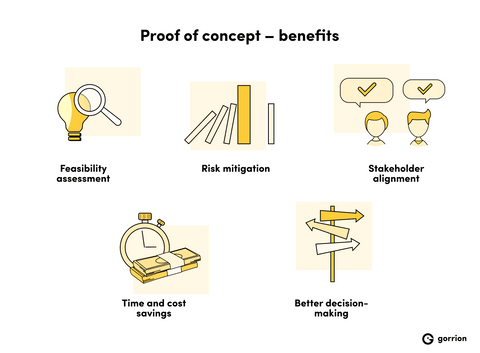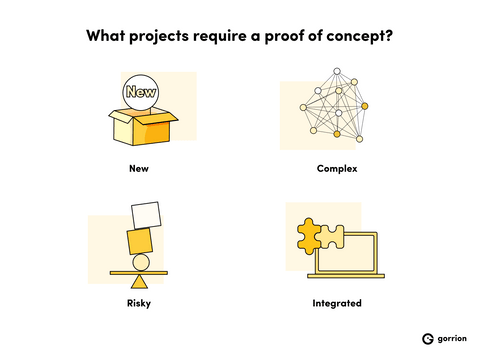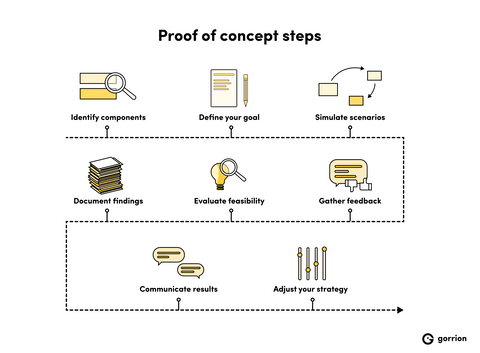


What is a proof of concept, and why you need it
Once upon a time, there was a visionary who had a business idea for a product that would revolutionize the market. The proud inventor found a software development company and asked them to design the product. They agreed. A lot of time and investor’s money had passed, yet still, there was no final product in sight. Finally, the project manager along with the team concluded that the product was impossible to create. As a result, they wasted time and money to prepare an unsatisfactory design.
So, what went wrong? What did the team miss in the process? The answer is simple. In software development it’s called a proof of concept (PoC).
Yes, developing software is time-consuming and comes in stages. It requires a lot of resources, that’s true, too. Which is why every new software idea should be validated first – not just from a business perspective, but also from the standpoint of technical feasibility. And the way to do it is through a proof of concept.
Learn about the meaning of PoC in software and the development process behind it.
What does a proof of concept (PoC) mean in software development?
In software development, a proof of concept is a demonstration or a prototype of a concept that’s created before the team starts to work on the actual project. The goal is to confirm that the product idea is technically feasible – to test whether a chosen approach / technology / design will work and deliver expected results.
The main motivation for having a proof of concept in a software development project is simple – risk avoidance. Since the development is time- and cost-consuming, it’s best to identify issues and challenges early on. A proof of concept, which focuses on one aspect or feature of the software product, allows you to do that safely.


Have a project in mind?
Let’s meet - book a free consultation and we’ll get back to you within 24 hrs.
A successful proof of concept will answer the following questions:
- is this concept doable (technically feasible)?
- does it meet performance criteria?
- how can we address the risks and challenges we’ve identifies?
So, as you can see – a PoC in software development heavily focuses on the technical aspects of the concept and on its “doability.” A ready PoC is still nowhere near a functioning product. This differentiates it from a minimum viable product (MVP), which is a version of the product that’s ready to be released to the target audience for testing.
Why is proof of concept important in software development?
We’ve briefly touched on why companies decide to develop a proof of concept. Now, let’s dive deeper into how it affects the software development process based on our experience at Gorrion.
Feasibility assessment
Before we start building a PoC, we analyze all the potential obstacles that stand in the way of the final product. We check everything that concerns software development – the technology itself, constraints and challenges, market demand, budget and business plan, intended audience, etc. All of this to choose the solutions that satisfy both business and market needs.
Risk mitigation
One of the most crucial benefits of doing a proof of concept is that it allows you to identify possible problems and limitations early on. This contributes to better understanding of the product. It also allows you to address the issues before you commit to further development.
The risks are minimized even more if you follow your proof of concept with a prototype. This allows for further tests. We can’t stress this enough – the testing stage is crucial when it comes to software development.
Lean more about testing and how to preserve the software quality from the separate article by Dominik Guzy, our CIO.
Stakeholder alignment
By involving stakeholders – the development team, project managers, and decision makers – and gathering valuable feedback, you can ensure that everyone is on the same page and make necessary adjustments based on their input. A proof of concept helps everyone understand the product and manage their expectations.
Time and cost savings
A proof of concept can save you money immediately (if it turns out the product idea is unfeasible), or in the long run. It can save your team unnecessary course corrections, circling in place, or even complete project failure. A PoC helps you find issues and improvements upfront. This leads to a more efficient and effective software development process down the road.
Informed decision-making
The findings gathered during this phase will help you make more informed decisions in the future. Oftentimes, a proof of concept will alter or entirely reshape the project direction. Sometimes it proves a technology won’t work or points to a better alternative. The feedback you gather now can help make adjustments to your project plan, refine the concept, reevaluate investment decisions, or even pivot entirely.
When should you consider a PoC?
It’s a popular misconception that in software development a PoC is only done when you create a new solution, which is not at all true. You may have a tried and tested off-the-shelf product and still need a PoC to prove it can be integrated with your internal tools. Or you may have an entire commercially available product and still need a proof of concept because you want to implement a new feature. When should you consider having a proof of concept first, then? Here are 4 scenarios.
Novelties – you want to try something new
Whether it’s a new technology, framework, or approach that you want to test and you don’t have much experience, start small and perform a proof of concept. It will help you determine whether the novelty is suitable for your case and understand its capabilities, limitations, and challenges.
Complexity – you approach something complicated
If your project is complex, you can break it up into smaller parts. Then you can test those separately and see how they work together. It may turn out just one component needs to be tweaked for the initial idea to work, or it may turn out that one component is a complete blocker.
Risk – you’re not sure what you want or that it will work
If there’s any doubt that your software idea will work or if you’re missing some answers, a PoC is the way to go. So before you commit to actual software development, see how it all looks on paper. A successful PoC will hopefully help you uncover all the issues and answer all your doubts.
Integration – your solution needs to work with something else
That’s a very common case for a proof of concept. If your software product needs to be integrated with other systems, services, or APIs, a proof of concept will determine whether they are compatible or if there’s something missing.
How to conduct a proof of concept
As a company, we’re always looking forward to new collaborations. Each client is treated individually, and each project requires a proper approach and analysis. From the first meeting to a product discovery workshop, we get to know the client, their idea and their business. We often advise building a proof of concept as a part of our development cycle. Here’s how we go about it:
- Identify components: at the very beginning start with technical specifications. What technologies, tools, and resources you want to use in your project? These are the things you’ll be testing later.
- Define your goal: clearly establish what’s the purpose of your proof of concept. Determine what exactly you want to validate and write down what questions need to be answered.
- Simulate scenarios: describe real-life use cases in which your software solution will be used. Test these scenarios to identify their usability, performance, and effectiveness.
- Gather feedback: share the PoC with stakeholders (development team, PMs, decision-makers) and your target audience and ask them to provide feedback. This will give you a different perspective.
- Evaluate feasibility: based on your research and feedback, assess if the project is doable and meets all the requirements. Are there any risks? Limitations? Better alternatives?
- Document findings: remember to collect and write down all the conclusions. You can write up a report summarizing your results, analyzing strengths and weaknesses, and providing your recommendations.
- Communicate results: based on your document, everyone will be able to make informed decisions about the project. Therefore, make sure to distribute it to everyone who’s involved to get everyone’s buy-in.
- Pivot: remember, software development is an iterative process. So be mindful of conclusions that advise modifying the scope, refining the concept, or changing technologies, and adjust course if necessary.
And what the other stages in product development lifecycle? Read our articles on minimum viable product and the difference between a prototype and a proof of concept to get the full picture!
Start your software proof of concept right away
As you can see, a proof of concept is an essential process in software development. It helps you assess technical feasibility, mitigate risks, align stakeholders, validate design and basic functionalities, save costs and time, and make informed decisions. Above all, it ensures that the concept has a solid foundation before you proceed with full-scale software development, increasing the chances of successful outcomes.
If you need a proof of concept for your software product, we can help! Tell us about your project, and we’ll run a thorough analysis. Book a free consultation with us, and let’s turn your idea into reality!
Editor’s note: We’ve originally published this post in July 2020 and updated it in July 2023 for comprehensiveness.


Have a project in mind?
Let’s meet - book a free consultation and we’ll get back to you within 24 hrs.
At Gorrion, Dominika Stankiewicz manages content. Having spent a decade in marketing and communications, she’s the master of the written word and the guardian of style. On our blog she shares her experience in B2B product marketing to help SaaS companies plan and execute their go-to-market strategy. In her spare time, she reviews manuscripts for publishers and bakes cakes. She loves cats, books, and American football.
Other worthy reads






